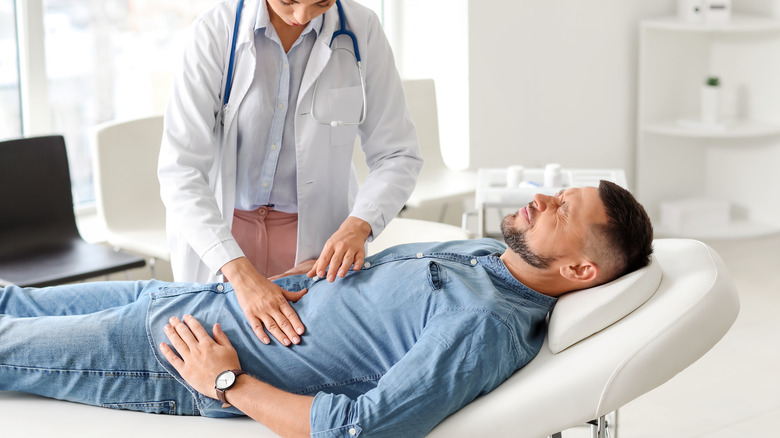Perineum Pain In Men: What Does It Mean?
Discussing the intimate areas of your body can be a little awkward, but understanding what pain in each area might mean can provide you with immense knowledge about your own health. In your groin area, you have your genitalia and your buttocks with an area between the two called the perineum (via Healthline). For men, the perineum is the area found between the scrotum skin and the start of the anal region, and it is a relatively small area of the body with attachments to muscles and nerve endings. Discerning the cause of perineum pain can be formally assessed by a medical specialist, but there are ways of better understanding this part of your body at home so that you can be equipped with a critical awareness of potential causes.
When injured, the perineum is generally categorized as a genital injury, per the National Institute of Diabetes and Digestive and Kidney Diseases. But the perineal region connects to far more than just the genitals, with the placement of the pelvic floor muscles right above the perineum. Since the pelvic floor muscles play a vital role in providing both the bowel, which expels through the anus, and the bladder, which is relieved through the urethra, with necessary structural support to maintain normal function, protecting and treating perineum pain can in turn reinforce the organs, muscles, blood vessels, and nerves of the surrounding internal components. Here's what can cause perineum pain in men and how it's treated.
The perineum is small but powerful
The perineal area is relatively small in comparison with other anatomical figures of the genital region, but the closeness of the perineum to so many key components affecting urinary, gastrointestinal, and digestive health makes it an important player, so pain to it should be monitored for additional symptoms, per Healthline. Prostatitis is a diagnosis that occurs when a man's prostate gland, which is responsible for the creation of seminal fluid, becomes inflamed. Prostate swelling can be caused by unknown causes that resolve on their own or by known reasons, like bacterial infections requiring antibiotics to treat. Should perineal pain be induced by prostatitis, accompanying side effects may include changes to urination color and symptoms that mimic the flu.
Given the closeness of the perineum to the pelvic floor muscles, hemorrhoids in the anal areas can lead to radiating pain in the perineal regions, according to Medical News Today. Hemorrhoid creams, sprays, washes, and sitz baths can help to ease pain in both the perineum and anal areas due to hemorrhoids, particularly pain from hemorrhoids placing direct pressure on the perineum with an emphasis on the visits to the bathroom to relieve oneself of stool. Some of the most well-known symptoms of hemorrhoids include bleeding during bowel movements and pain that increases in the rectal area in the immediate aftermath of going to the restroom. However, it's also best to track how the perineum feels during and after bowel movements.


